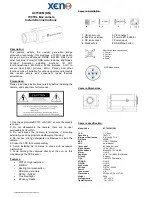
LENS TECHNOLOGY
Hyper-Sonic Motor (HSM):
HSM lenses are equipped with a motor driven by ultrasonic waves.
The motor makes high AF speeds and quiet shooting a reality.
Rear Focus:
RF lenses are equipped with a focusing system that moves the rear
lens group for high-speed, silent focusing.
Inner Focus:
IF lenses are equipped with a focusing system that moves the inner
lens group without changing the physical length of the lens, thereby
ensuring excellent stability in focusing.
Teleconverter-Compatible Lens (CONV):
The “CONV” mark designates lenses that can be used with the APO
Teleconverter EX (sold separately). The teleconverter increases the
focal length and interfaces with the AE (automatic exposure) function
of the lens.
EX Lens:
With uncompromised design ideas and high-level optical technology
and handling, these lenses, which are Sigma’s representative lenses,
meet the requirements of photographers at the highest level.
Aspherical Lens:
The aspherical lens complex allows freedom of design, with high lens
performance, reduced number of components, and compact size.
APO Lens:
Using SLD, ELD, and other special low-dispersion glass, these lenses
are designed to minimize chromatic aberration and deliver the best
image quality possible.
Optical Stabilizer (OS):
This is a feature built into lenses that compensates for camera shake.
It dramatically expands the realms of photography by alleviating
camera movement when shooting handheld.
SIGMA Advanced Lens Technology
SIGMA High-Performance Lens Series
DC Lens
These are dedicated digital SLR camera lenses with an image circle
designed to suit image sensors that correspond to APS-C size. In-
house technology accumulated through the development of our digital
SLR camera was used to optimize optical performance for our digital
lenses. This is a high-performance lens series that fuses technology such
as lens power layout and coating design with the know-how Sigma has
built up over many years of developing interchangeable lenses for SLR
cameras. By reducing the diameter of the image circle, Sigma has
achieved a more compact, lightweight lens series.
* An image sensor larger than those corresponding to the APS-C size cannot be used in digital
SLR cameras, 35 mm SLR cameras, or APS film SLR cameras. If such an element is used,
vignetting will occur on the picture surface.
The angle of view varies depending on which camera model the lens is used with.
35mm format is approximately 1.5 - 2.0 times the focal length of the lens being used.
DG Lenss
These are high-performance lenses optimized for digital cameras.
They are ideal not only for 35 mm digital SLR cameras and film digital
SLR cameras but also for APS-C digital SLR cameras. They deliver
superior image quality by correcting for all types of aberration,
especially distortion, and they have high resolution capability because
they minimize chromatic aberration of magnification, which is
particularly a problem for digital cameras. What is more, these lenses
incorporate optical designs optimized for digital cameras and Sigma‘s own
Super Multi-Layer Coating technology, so they reduce flare and
ghosting due to reflection between the image sensor and lens
surfaces, and they provide high contrast and a wide range of tone.
They also provide enough peripheral brightness with little vignetting.
Sigma lens technology-- what photographers always rely on when they want to express themselves through images.
Sigma is always developing state-of-the-art optical technology to draw out the maximum possibilities of
single-lens reflex cameras and give photographers the tools they need to do exactly what they want,
and the fruits of that development are embodied in each and every Sigma lens.
Summary of Contents for 10-20mm F4-5.6 EX DC / HSM
Page 1: ......

































